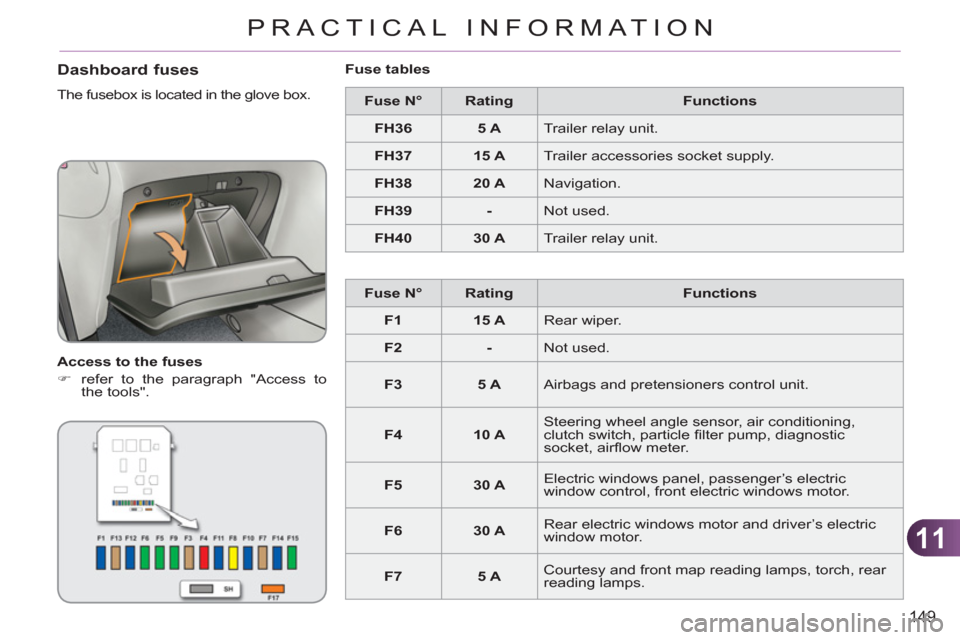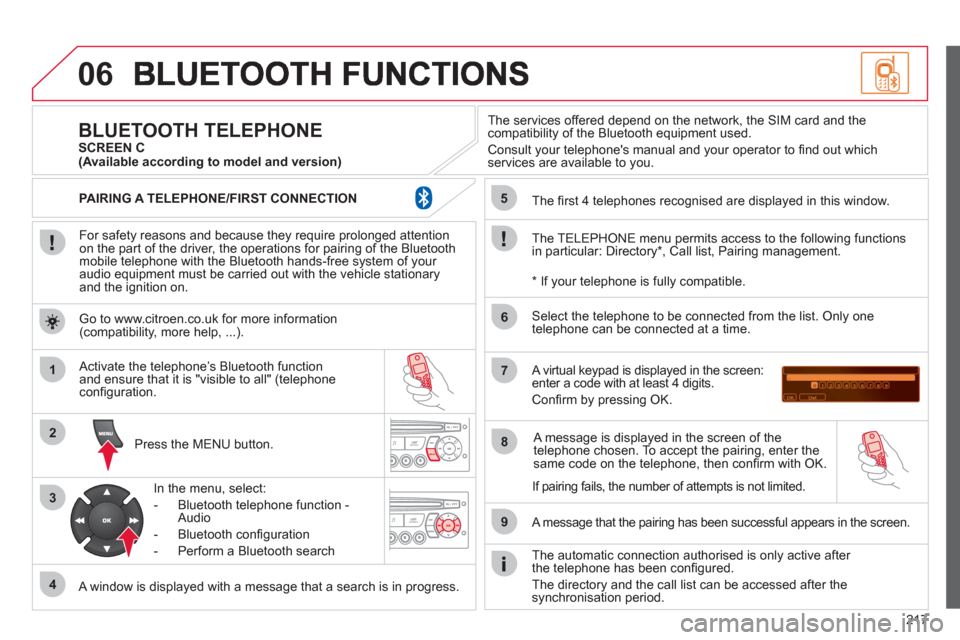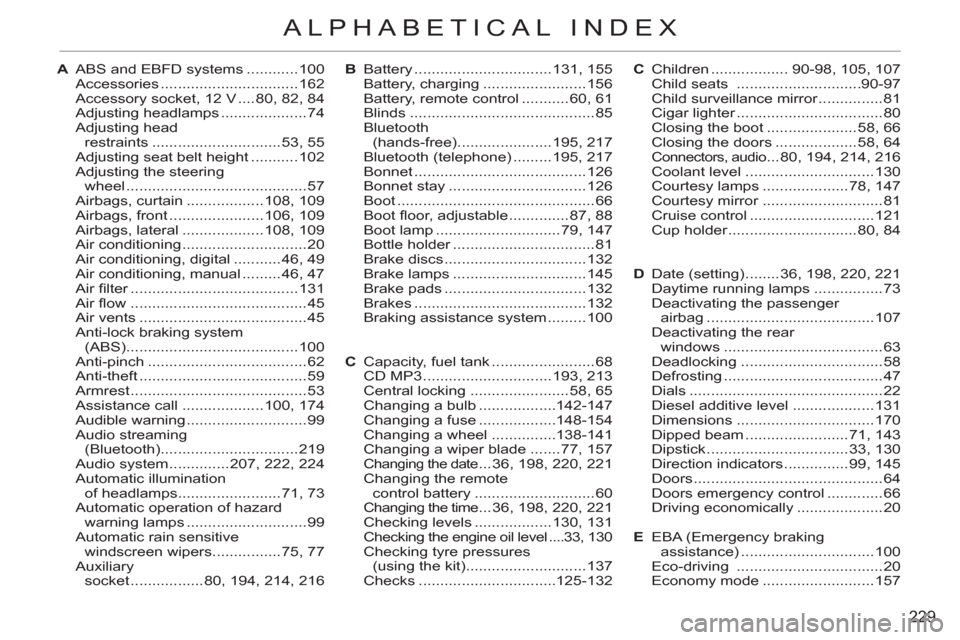window Citroen C3 PICASSO RHD 2012 1.G User Guide
[x] Cancel search | Manufacturer: CITROEN, Model Year: 2012, Model line: C3 PICASSO RHD, Model: Citroen C3 PICASSO RHD 2012 1.GPages: 244, PDF Size: 8.31 MB
Page 64 of 244

4
62
ACCESS
WINDOW CONTROLS
System which opens or closes a win-
dow manually or automatically. It is
fi tted with anti-pinch protection if an
obstacle is detected on the one-touch
models and a deactivation system to
prevent misuse of the rear switches on
all models.
1.
Driver's electric window control
switch.
2.
Passenger's electric window con-
trol switch.
3.
Rear right electric window control
switch.
4.
Rear left electric window control
switch.
5.
Deactivating the rear electric win-
dow and door controls.
In the event of unwanted opening of
the window on closing (for example
in the presence of frost):
�)
press the switch until it opens
completely,
�)
then pull it immediately until
it closes,
�)
continue to hold the switch
for approximately one second
after the window has closed.
The safety anti-pinch function is
not active during these opera-
tions.
Safety anti-pinch
The one-touch electric windows are fi t-
ted with a safety anti-pinch function.
When the window rises and meets an
obstacle, it stops and partially lowers
again. The electric window switches
remain operational for approxi-
mately 45 seconds after the igni-
tion is switched off or until a front
door is opened.
Electric windows
�)
Press or pull the switch. The
window stops as soon as
the switch is released.
One-touch electric windows
There are two methods
of operation:
- manual mode
�)
Press or pull the switch gently.
The window stops as soon as the
switch is released.
- automatic mode
�)
Press or pull the switch fully. The
window opens or closes complete-
ly when the switch is released.
�)
Pressing the switch again stops
the movement of the window.
The electric window switches
remain operational for approxi-
mately 45 seconds after the igni-
tion is switched off or until a front
door is opened.
Page 65 of 244

4
63
ACCESS
Deactivating the rear window and
door controls Always remove the key from the
ignition when leaving the vehicle,
even for a short time.
In the event of contact during
operation of the windows, you
must reverse the movement of
the window. To do this, press the
switch concerned.
When the driver operates the
passenger electric window
switches, they must ensure that
no one is preventing correct
closing of the windows.
The driver must ensure that the
passengers use the electric win-
dows correctly.
Be aware of children when ope-
rating the windows. Reinitialisation
In the event of a malfunction you must
reinitialise the operation of the electric
windows:
�)
release the switch and pull it again
until the window closes completely,
�)
hold the switch for approximately
one second after closing,
�)
press the switch to lower the win-
dow automatically.
The safety anti-pinch function is not
active during these operations.
�)
For the safety of your children, press
switch 5
to prevent operation of the
rear windows irrespective of their
position.
With the indicator lamp on, the rear con-
trols are deactivated.
With the indicator lamp off, the rear con-
trols are activated.
When the function is activated, this
warning lamp lights up on the in-
strument panel for a few seconds.
This control also deactivates the
interior rear door controls (see
"Child safety - § Electric child
lock").
Page 87 of 244

6
85
FITTINGS
Lift the catch to release the table and
unfold it.
Aircraft style tables
Reading lamps are built into the back of
the front seats, behind the tables. With
the ignition on, they illuminate the top of
the table without inconveniencing other
passengers.
They are only accessible if the table is
unfolded.
�)
Press the button to switch the lamp
on or off.
Individual reading lamps
Do not place hard or heavy ob-
jects on the table. They could
become dangerous projectiles
in the event of sharp braking or
impact.
As a safety precaution, if too
much pressure is exerted the
table will fold downwards.
Side blinds
Blinds are available for the side windows.
Pull the side blind longways by the tab
to use it.
Always guide the blind slowly using
the tab.
Page 96 of 244

7
CHILD SAFETY
ADVICE ON CHILD SEATS
Installing a booster seat
The chest part of the seat belt must
be positioned on the child's shoulder
without touching the neck.
Ensure that the lap part of the seat
belt passes correctly over the child's
thighs.
CITROËN recommends the use of
a booster seat which has a back, fi t-
ted with a seat belt guide at shoulder
level. As a safety precaution, do not leave:
- a child or children alone and un-
supervised in a vehicle,
- a child or an animal in a vehicle
which is exposed to the sun, with
the windows closed,
- the keys within reach of children
inside the vehicle.
To prevent accidental opening of the
doors and rear windows, use the
"Child lock".
Take care not to open the rear win-
dows by more than one third.
To protect young children from the
rays of the sun, fi t side blinds on the
rear windows.
The incorrect installation of a child
seat in a vehicle compromises the
child's protection in the event of an
accident.
Remember to fasten the seat belts or
the child seat harnesses keeping the
slack relative to the child's body to a
minimum, even for short journeys.
When installing a child seat using the
seat belt, ensure that the seat belt is
tightened correctly on the child seat
and that it secures the child seat fi rm-
ly on the seat of your vehicle. If your
passenger seat is adjustable, move it
forwards if necessary.
For optimum installation of the "for-
wards-facing" child seat, ensure that
the back of the child seat is in contact
with the back of the vehicle's seat
and that the head restraint does not
cause any discomfort.
If the head restraint has to be removed, ensure that it is stored or attached se-
curely to prevent it from being thrown
around the vehicle in the event of
sharp braking. Children under the age of 10 must
not travel in the "forwards-facing"
position on the front passenger seat,
unless the rear seats are already oc-
cupied by other children, cannot be
used or are absent.
Deactivate the passenger airbag
when a "rearwards-facing" child seat
is installed on the front seat.
Otherwise, the child would risk being
seriously injured or killed if the airbag
were to infl ate.
Page 100 of 244

7
98
CHILD SAFETY
This system is independent and
in no circumstances does it take
the place of the central locking
control.
Check the status of the child lock
each time you switch on the igni-
tion.
Always remove the key from the
ignition when leaving the vehi-
cle, even for a short time.
In the event of a serious impact,
the electric child lock is switched
off automatically to permit the
exit of the rear passengers.
ELECTRIC CHILD LOCK
Control system to prevent opening of the
rear doors using their interior controls
and use of the rear electric windows.
The control is located on the driver’s
door, with the electric window controls,
or on the dashboard switch panel, if
your vehicle is fi tted with manual rear
windows.
�)
Press button A
.
The indicator lamp in button A
comes
on, accompanied by a message in the
multifunction screen.
This indicator lamp remains on until the
child lock is switched off.
Switching on
Switching off
�)
Press button A
again.
The indicator lamp in button A
goes off,
accompanied by a message in the mul-
tifunction screen.
This indicator lamp remains off until the
child lock is switched on.
Any other status of the indica-
tor lamp indicates a fault with
the electric child lock. Have it
checked by a CITROËN dealer
or a qualifi ed workshop.
Switching the child lock on is
confi rmed by the temporary illu-
mination of this warning lamp in
the translucent instrument panel.
Page 110 of 244

8
108
SAFETY
Lateral airbags
System which protects the driver and
front passenger in the event of a seri-
ous side impact in order to limit the risk
of injury to the chest, between the hip
and the shoulder.
Each lateral airbag is fi tted in the seat
backrest frame, door side.
Deployment
The lateral airbags are deployed unilater-
ally in the event of a serious side impact
applied to all or part of the side impact
zone B
, perpendicular to the longitudinal
centreline of the vehicle on a horizontal
plane and directed from the outside to-
wards the inside of the vehicle.
Curtain airbags
System which protects the driver and
passengers (with the exception of the
rear centre passenger) in the event of a
serious side impact in order to limit the
risk of injury to the side of the head.
Each curtain airbag is built into the pillars
and the upper passenger compartment
area.
Operating fault
Deployment
The curtain airbag is deployed at the same
time as the corresponding lateral airbag in
the event of a serious side impact applied
to all or part of the side impact zone B
,
perpendicular to the longitudinal cen-
treline of the vehicle on a horizontal plane
and directed from the outside towards the
inside of the vehicle.
The curtain airbag infl ates between the
front or rear occupant of the vehicle and
the windows.
In the event of a minor impact or
bump on the side of the vehicle
or if the vehicle rolls over, the
airbag may not be deployed.
In the event of a rear or front
collision, the airbag is not de-
ployed.
Impact detection zones
A.
Front impact zone.
B.
Side impact zone.
If this warning lamp comes on
in the instrument panel, accom-
panied by an audible signal and
a message in the screen, con-
tact a CITROËN dealer or a qualifi ed
workshop to have the system checked.
The airbags may no longer be deployed
in the event of a serious impact. The lateral airbag infl ates between the
hip and shoulder of the front occupant
of the vehicle and the corresponding
door trim panel.
Page 151 of 244

11
149
PRACTICAL INFORMATION
Dashboard fuses
The fusebox is located in the glove box.
Access to the fuses
�)
refer to the paragraph "Access to
the tools".
Fuse tables
Fuse N°
Rating
Functions
FH36
5 A
Trailer relay unit.
FH37
15 A
Trailer accessories socket supply.
FH38
20 A
Navigation.
FH39
-
Not used.
FH40
30 A
Trailer relay unit.
Fuse N°
Rating
Functions
F1
15 A
Rear wiper.
F2
-
Not used.
F3
5 A
Airbags and pretensioners control unit.
F4
10 A
Steering wheel angle sensor, air conditioning,
clutch switch, particle fi lter pump, diagnostic
socket, airfl ow meter.
F5
30 A
Electric windows panel, passenger’s electric
window control, front electric windows motor.
F6
30 A
Rear electric windows motor and driver’s electric
window motor.
F7
5 A
Courtesy and front map reading lamps, torch, rear
reading lamps.
Page 194 of 244

192
07MUSIC MEDIA PLAYERS
CD, MP3/WMA CD
INFORMATION AND ADVICE
In order to be able to play a recorded CDR or CDRW, when recording it is preferable to select the ISO 9660 level 1, 2 or Jolietstandard.
I
f the disc is recorded in another format it may not be playedcorrectly.
It is recommended that the same recordin
g standard is alwaysused for an individual disc, with as low a speed as possible(4x maximum) for optimum sound quality.
In the particular case o
f a multi-session CD, the Joliet standard is recommended.
The M
yWay will only play audio fi les with the extension ".mp3"
with a speed of between 8 Kbps and 320 Kbps and the extension
".wma" with a speed of between 5 Kbps and 384 Kbps.
It also supports the VBR
(Variable Bit Rate) mode.
No other t
ype of fi le (.mp4, .m3u...) can be played. The MP3
format, an abbreviation of MPEG 1, 2 & 2.5 Audio Layer 3 and the WMA format, an abbreviation of Windows Media Audio and
the property of Microsoft, are audio compression standards which permit the recording of several tens of music fi les on a single disc.
It is advisable to restrict fi le names to 20 characters
, without
using special characters (e.g.: " ? ; ù) to avoid any play or display
problems.
Page 219 of 244

217
06
1
2
3
4
5
6
7
8
9
MENU
OK
For safety reasons and because they require prolonged attentionon the part of the driver, the operations for pairing of the Bluetooth mobile telephone with the Bluetooth hands-free system of your
audio equipment must be carried out with the vehicle stationary
and the ignition on.
Pr
ess the MENU button.
A window is displayed with a message that a search is in progress.
Activate the telephone’s Bluetooth
function
and ensure that it is "visible to all" (telephone confi guration.
In the menu, select:
- Bluetooth telephone
function -
Audio
- Bluetooth confi
guration
- P
erform a Bluetooth search
The services o
ffered depend on the network, the SIM card and thecompatibility of the Bluetooth equipment used.
Consult your telephone's manual and your operator to fi nd out which
services are available to you.
BLUETOOTH TELEPHONE SCREEN C
The TELEPH
ONE menu permits access to the following functions
in particular: Directory * , Call list, Pairing management.
The
fi rst 4 telephones recognised are displayed in this window.
A virtual ke
ypad is displayed in the screen: enter a code with at least 4 digits.
Confi rm by pressing OK.
A messa
ge that the pairing has been successful appears in the screen.
Select the telephone to be connected from the list. Only one
telephone can be connected at a time.
A messa
ge is displayed in the screen of the
telephone chosen. To accept the pairing, enter the same code on the telephone, then confi rm with OK.
The automatic connection authorised is onl
y active after
the telephone has been confi gured.
The directory and the call list can be accessed a
fter thesynchronisation period.
(Available according to model and version)
*
If your telephone is fully compatible.
I
f pairing fails, the number of attempts is not limited.
Go to www.citroen.co.uk for more information(compatibility, more help, ...).
PAIRING A TELEPHONE/FIR
ST CONNECTION
Page 231 of 244

229
ALPHABETICAL INDEX
A ABS and EBFD systems ............100
Accessories ................................162
Accessory socket, 12 V ....80, 82, 84
Adjusting headlamps ....................74
Adjusting head
restraints ..............................53, 55
Adjusting seat belt height ...........102
Adjusting the steering
wheel ..........................................57
Airbags, curtain ..................108, 109
Airbags, front ......................106, 109
Airbags, lateral ...................108, 109
Air conditioning .............................20
Air conditioning, digital ...........46, 49
Air conditioning, manual .........46, 47
Air fi lter .......................................131
Air fl ow .........................................45
Air vents .......................................45
Anti-lock braking system
(ABS) ........................................100
Anti-pinch .....................................62
Anti-theft .......................................59
Armrest .........................................53
Assistance call ...................100, 174
Audible warning ............................99
Audio streaming
(Bluetooth) ................................219
Audio system ..............207, 222, 224
Automatic illumination
of headlamps ........................71, 73
Automatic operation of hazard
warning lamps ............................99
Automatic rain sensitive
windscreen wipers ................75, 77
Auxiliary
socket .................80, 194, 214, 216B Battery ................................131, 155
Battery, charging ........................156
Battery, remote control ...........60, 61
Blinds ...........................................85
Bluetooth
(hands-free) ......................195, 217
Bluetooth (telephone) .........195, 217
Bonnet ........................................126
Bonnet stay ................................126
Boot ..............................................66
Boot fl oor, adjustable ..............87, 88
Boot lamp .............................79, 147
Bottle holder .................................81
Brake discs .................................132
Brake lamps ...............................145
Brake pads .................................132
Brakes ........................................132
Braking assistance system .........100
C Capacity, fuel tank ........................68
CD MP3 ..............................193, 213
Central locking .......................58, 65
Changing a bulb ..................142-147
Changing a fuse ..................148-154
Changing a wheel ...............138-141
Changing a wiper blade .......77, 157
Changing the date ...36, 198, 220, 221
Changing the remote
control battery ............................60
Changing the time ...36, 198, 220, 221
Checking levels ..................130, 131
Checking the engine oil level ....33, 130
Checking tyre pressures
(using the kit) ............................137
Checks ................................125-132C Children .................. 90-98, 105, 107
Child seats .............................90-97
Child surveillance mirror ...............81
Cigar lighter ..................................80
Closing the boot .....................58, 66
Closing the doors ...................58, 64
Connectors, audio ...80, 194, 214, 216
Coolant level ..............................130
Courtesy lamps ....................78, 147
Courtesy mirror ............................81
Cruise control .............................121
Cup holder ..............................80, 84
D Date (setting) ........36, 198, 220, 221
Daytime running lamps ................73
Deactivating the passenger
airbag .......................................107
Deactivating the rear
windows .....................................63
Deadlocking .................................58
Defrosting .....................................47
Dials .............................................22
Diesel additive level ...................131
Dimensions ................................170
Dipped beam ........................71, 143
Dipstick .................................33, 130
Direction indicators ...............99, 145
Doors ............................................64
Doors emergency control .............66
Driving economically ....................20
E EBA (Emergency braking
assistance) ...............................100
Eco-driving ..................................20
Economy mode ..........................157